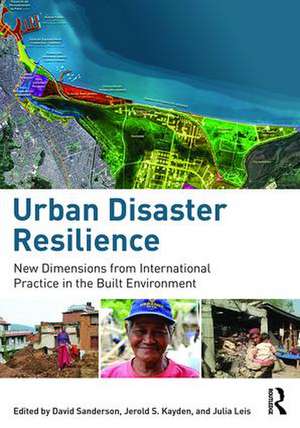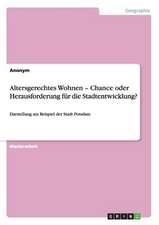Urban Disaster Resilience: New Dimensions from International Practice in the Built Environment
Editat de David S. Anderson, Jerold Kayden, Julia Leisen Limba Engleză Paperback – 11 apr 2016
Drawing directly from the experiences of urban disasters in the Philippines, Chile, India, Thailand, Iraq, Haiti and Nepal, among other countries, Urban Disaster Resilience brings to light new collaborations and techniques for addressing the challenges of urban disasters in the coming years. Chapters range from country-specific case studies to more synthetic frameworks in order to promote innovative thinking and practical solutions.
Edited by David Sanderson, Jerold S. Kayden and Julia Leis, this book is a crucial read for humanitarian and disaster specialists, urban planners and designers, architects, landscape architects, housing and economic development professionals, real estate developers, private business managers and students interested in the subject, whether based in non-governmental organizations, local, state or national governments, international agencies, private firms, or the academy.
| Toate formatele și edițiile | Preț | Express |
|---|---|---|
| Paperback (1) | 438.09 lei 6-8 săpt. | |
| Taylor & Francis – 11 apr 2016 | 438.09 lei 6-8 săpt. | |
| Hardback (1) | 1038.07 lei 6-8 săpt. | |
| Taylor & Francis – 13 apr 2016 | 1038.07 lei 6-8 săpt. |
Preț: 438.09 lei
Nou
Puncte Express: 657
Preț estimativ în valută:
83.82€ • 87.53$ • 69.22£
83.82€ • 87.53$ • 69.22£
Carte tipărită la comandă
Livrare economică 15-29 aprilie
Preluare comenzi: 021 569.72.76
Specificații
ISBN-13: 9781138849631
ISBN-10: 1138849634
Pagini: 250
Ilustrații: 4 black & white tables, 47 black & white halftones, 32 colour illustrations, 9 black & white line drawings
Dimensiuni: 178 x 254 x 15 mm
Greutate: 0.5 kg
Ediția:1
Editura: Taylor & Francis
Colecția Routledge
Locul publicării:Oxford, United Kingdom
ISBN-10: 1138849634
Pagini: 250
Ilustrații: 4 black & white tables, 47 black & white halftones, 32 colour illustrations, 9 black & white line drawings
Dimensiuni: 178 x 254 x 15 mm
Greutate: 0.5 kg
Ediția:1
Editura: Taylor & Francis
Colecția Routledge
Locul publicării:Oxford, United Kingdom
Public țintă
Postgraduate, Professional, Professional Practice & Development, and UndergraduateCuprins
Introduction Part I. Urban planning, design and cities 1. Designing resilient cities and neighborhoods 2. Reconstructing the city: the potential gains of using urban planning and design practices in recovery and why they are so difficult to achieve 3. Fables from the reconstruction: lessons from Chile’s recovery after the 2010 earthquake and tsunami 4. Risk, resilience and the fragile city Part II. People, places, complex systems and regulation 5. Urban disaster resilience: learning from the 2011 Bangkok, Thailand, flood using morphology and complex adaptive systems 6. Regulatory barriers and the provision of shelter in post-disaster situations: housing, land and property (HLP) issues in the recovery of Tacloban, the Philippines, after Typhoon Haiyan 7. How does reconstruction after disaster affect long-term resilience? 8. Conflict and urban displacement: the impact on Kurdish place-identity in Erbil, Iraq Part III. Urban markets, micro-enterprise, insurance and technology 9. Linking response, recovery and resilience to markets in humanitarian action 10. Petty trade and the private sector in urban reconstruction: learning from Haiti’s post-earthquake Iron Market 11. Using disaster insurance to build urban resilience: lessons from micro-enterprise in India 12. ‘Humanitarian hybrids’: new technologies and humanitarian resilience Epilogue Reflections on the practice of disaster resilience
Notă biografică
David Sanderson is the Inaugural Judith Neilson Chair of Architecture at the University of New South Wales (UNSW), Australia. He has held senior posts in both NGO and academic sectors, and has carried out work for a number of NGOs and donor organizations. In recent years he has led post-disaster reviews in Haiti, Pakistan, Bangladesh, India, the Philippines and Nepal.
Jerold S. Kayden is the Frank Backus Williams Professor of Urban Planning and Design at the Harvard University Graduate School of Design. He has consulted for the World Bank, USAID and UNDP, worldwide, and served as principal investigator of the Harvard-Netherlands Project on Climate Change, Water, Land Development, and Adaptation. He is an affiliated faculty member of the Harvard Humanitarian Initiative (HHI).
Julia Leis is a humanitarian relief and development worker. She has completed assignments in the Philippines, Gaza, Burkina Faso and Thailand. She holds a Master of Arts from The Fletcher School of Law and Diplomacy at Tufts University and a degree in Foreign Service from Georgetown University.
Jerold S. Kayden is the Frank Backus Williams Professor of Urban Planning and Design at the Harvard University Graduate School of Design. He has consulted for the World Bank, USAID and UNDP, worldwide, and served as principal investigator of the Harvard-Netherlands Project on Climate Change, Water, Land Development, and Adaptation. He is an affiliated faculty member of the Harvard Humanitarian Initiative (HHI).
Julia Leis is a humanitarian relief and development worker. She has completed assignments in the Philippines, Gaza, Burkina Faso and Thailand. She holds a Master of Arts from The Fletcher School of Law and Diplomacy at Tufts University and a degree in Foreign Service from Georgetown University.
Recenzii
"Urban Disaster Resilience could not have been more timely. Following global processes in 2015, including the newly adopted Sustainable Development Goals, and the World Humanitarian Summit and Habitat III in 2016, this book has successfully captured a broad understanding of what needs to happen for resilience to be achieved. It will be an important introduction and reference to the subject and should be recommended reading for students of architecture, development and humanitarian studies, as well as policy makers and practitioners alike." Jemilah Mahmood, Under Secretary General, IFRC (Partnerships)
"This is a unique and timely volume of innovations and insights into the theory and practice of building urban resilience. Drawing on international experience, and illustrated throughout with case examples, its authors argue the value of informality and of engaging civil society when planning for the challenges of humanitarian crisis. An excellent resource book for teaching, for research and for practice." Nabeel Hamdi, Emeritus Professor, Oxford Brookes University
"Urban Disaster Resilience is a must read for those trying to catalyze resilience building in humanitarian and development assistance. It warns that humanitarian assistance is not only failing to meet the needs of an increasingly urban planet, but that its lack of a sense of space and place makes it ill equipped to do so without dramatic change." Nancy Kete, Managing Director, The Rockefeller Foundation
"This is a unique and timely volume of innovations and insights into the theory and practice of building urban resilience. Drawing on international experience, and illustrated throughout with case examples, its authors argue the value of informality and of engaging civil society when planning for the challenges of humanitarian crisis. An excellent resource book for teaching, for research and for practice." Nabeel Hamdi, Emeritus Professor, Oxford Brookes University
"Urban Disaster Resilience is a must read for those trying to catalyze resilience building in humanitarian and development assistance. It warns that humanitarian assistance is not only failing to meet the needs of an increasingly urban planet, but that its lack of a sense of space and place makes it ill equipped to do so without dramatic change." Nancy Kete, Managing Director, The Rockefeller Foundation
Descriere
Design for Urban Disaster brings together writings from humanitarian aid workers and built environmental practitioners to address the crucial questions around improving disaster response, building long term resilience and transformation, which explores the fundamental changes that reduce or even prevent future disaster.




